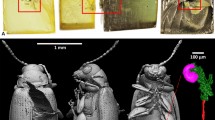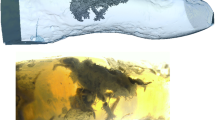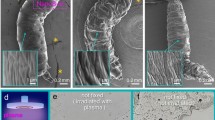Abstract
Synchrotron-based techniques offer a wealth of elemental, molecular, and structural insights in biological samples, but the application of these techniques to fossils is a relatively new development. Here we examine how synchrotron radiation micro X-ray fluorescence (SR µXRF) may be used to investigate the chemical composition of insects trapped in amber, while leaving the inclusions unaltered. Elemental distribution data could provide important information on tissue preservation in insect inclusions, as well as information on the processes involved in fossilization. By analyzing a series of ants (Hymenoptera: Formicidae) that range from modern material, to Eocene Baltic amber, and Late Cretaceous North Carolina amber, we investigate how variable preservation influences the results obtained through SR µXRF analyses, as well as the various merits and pitfalls associated with the application of this technique to amber inclusions. This work serves as an introduction to the underlying principles, strengths, and limitations associated with applying SR µXRF in a palaeontological context.






Similar content being viewed by others
References
Barling, N., D.M. Martill, S.W. Heads, and S. Gallien. 2015. High fidelity preservation of fossil insects from the Crato Formation (Lower Cretaceous) of Brazil. Cretaceous Research 52: 605–622.
Bergmann, U., R.W. Morton, P.L. Manning, W.I. Sellers, S. Farrar, K.G. Huntley, R.A. Wogelius, and P. Larson. 2010. Archaeopteryx feathers and bone chemistry fully revealed via synchrotron imaging. Proceedings of the National Academy of Sciences 107 (20): 9060–9065.
Bergmann, U., P.L. Manning, and R.A. Wogelius. 2012. Chemical mapping of paleontological and archeological artifacts with synchrotron X-rays. Annual Review of Analytical Chemistry 5: 361–389.
Brun, R, and F. Rademakers. 1997. ROOT—an object oriented data analysis framework. Nuclear Instruments and Methods in Physics Research A 389: 81–86 (Proceedings AIHENP’96 Workshop, Lausanne, Sep. 1996) (see also http://root.cern.ch/).
Clark, N.D., and C. Daly. 2010. Using confocal laser scanning microscopy to image trichome inclusions in amber. Journal of Paleontological Techniques 8: 1–7.
Edgecombe, G.D., V. Vahtera, S.R. Stock, A. Kallonen, X. Xiao, A. Rack, and G. Giribet. 2012. A scolopocryptopid centipede (Chilopoda: Scolopendromorpha) from Mexican amber: synchrotron microtomography and phylogenetic placement using a combined morphological and molecular data set. Zoological Journal of the Linnean Society 166 (4): 768–786.
Edwards, N.P., H.E. Barden, B.E. Van Dongen, P.L. Manning, P.L. Larson, U. Bergmann, W.I. Sellers, and R.A. Wogelius. 2011. Infrared mapping resolves soft tissue preservation in 50 million year-old reptile skin. Proceedings of the Royal Society of London (B: Biological Sciences) 278 (1722): 3209–3218.
Glocker, R., and H. Schreiber. 1928. Quantitative Röntgenspektralanalyse mit Kalterregung des Spektrums. Annalen der Physik 390 (8): 1089–1102.
Greenwalt, D.E., Y.S. Goreva, S.M. Siljeström, T. Rose, and R.E. Harbach. 2013. Hemoglobin-derived porphyrins preserved in a Middle Eocene blood-engorged mosquito. Proceedings of the National Academy of Sciences USA 110 (1849): 18496–18500.
Grimaldi, D., E. Bonwich, M. Delannoy, and S. Doberstein. 1994. Electron microscopic studies of mummified tissues in amber fossils. American Museum Novitates 3097: 1–31.
Grimaldi, D.A., and M.S. Engel. 2005. Evolution of the insects. New York: Cambridge University Press.
Henderickx, H., J. Bosselaers, E. Pauwels, L. Van Hoorebeke, and M. Boone. 2013. X-ray micro-CT reconstruction reveals eight antennomeres in a new fossil taxon that constitutes a sister clade to Dundoxenos and Triozocera (strepsiptera: corioxenidae). Palaeontologia Electronica 16 (3): 16–31.
Henwood, A. 1992a. Exceptional preservation of dipteran flight muscle and the taphonomy of insects in amber. Palaios 7 (2): 203–212.
Henwood, A. 1992b. Soft-part preservation of beetles in Tertiary amber from the Dominican Republic. Palaeontology 35 (4): 901–912.
Hu, Y.F., I. Coulthard, D. Chevrier, G. Wright, R. Igarashi, A. Sitnikov, B.W. Yates, T.K. Hallin, T.K. Sham, and R. Reininger. 2010. Preliminary commissioning and performance of the soft X-ray micro-characterization beamline at the Canadian Light Source. AIP Conference Proceedings 1234: 343–346.
Kirejtshuk, A.G., D. Azar, P. Tafforeau, R. Boistel, and V. Fernandez. 2009. New beetles of Polyphaga (Coleoptera, Polyphaga) from Lower Cretaceous lebanese amber. Denisia 26: 119–130.
Krynicki, V.E. 2013. Primitive ants (Hymenoptera: Sphecomyrminae) in the Campanian (Late Cretaceous) of North Carolina (USA). Life: The Excitement of Biology 1: 156–165.
Lak, M., D. Néraudeau, A. Nel, P. Cloetens, V. Perrichot, and P. Tafforeau. 2008. Phase contrast X-ray synchrotron imaging: opening access to fossil inclusions in opaque amber. Microscopy and Microanalysis 14: 251–259.
Martínez-Delclòs, X., D.E.G. Briggs, and E. Peñalver. 2004. Taphonomy of insects in carbonates and amber. Palaeogeography, Palaeoclimatology, Palaeoecology 203: 19–64.
McKellar, R.C., B.D.E. Chatterton, A.P. Wolfe, and P.J. Currie. 2011. A diverse assemblage of Late Cretaceous dinosaur and bird feathers from Canadian amber. Science 333 (6049): 1619–1622.
McNamara, M., P.J. Orr, S.L. Kearns, L. Alcalá, P. Anadón, and E. Peñalver-Mollá. 2010. Organic preservation of fossil musculature with ultracellular detail. Proceedings of the Royal Society of London B: Biological Sciences 277: 423–427.
Nichol, H., J.H. Law, and J.J. Winzerling. 2002. Iron metabolism in insects. Annual Review of Entomology 47: 535–559.
Schweitzer, M.H., W. Zheng, T.P. Cleland, M.B. Goodwin, M.B. Goodwin, E. Boatman, E. Theil, M.A. Marcus, and S.C. Fakra. 2013. A role for iron and oxygen chemistry in preserving soft tissues, cells and molecules from deep time. Proceedings of the Royal Society of London (B: Biological Sciences) 281 (1775): 20132741.
Solé, V.A., E. Papillon, M. Cotte, P. Walter, and J. Susini. 2007. A multiplatform code for the analysis of energy-dispersive X-ray fluorescence spectra. Spectrochimica Acta (Part B: Atomic Spectroscopy) 62: 63–68.
Soriano, C., M. Archer, D. Azar, P. Creaser, X. Delclòs, H. Godthelp, S. Hand, A. Jones, A. Nel, D. Néraudeau, and J. Ortega-Blanco. 2010. Synchrotron X-ray imaging of inclusions in amber. Comptes Rendus Palevol 9 (6): 361–368.
Speranza, M., J. Wierzchos, J. Alonso, L. Bettuchi, A. Martín-González, and C. Ascaso. 2010. Traditional and new microscopy techniques applied to the study of microscopic fungi included in amber. Microscopy: Science, Technology, Application and Education 2: 1135–1145.
Tafforeau, P., R. Boistel, E. Boller, A. Bravin, M. Brunet, Y. Chaimanee, P. Cloetens, M. Feist, J. Hoszowska, J.J. Jaeger, and R.F. Kay. 2006. Applications of X-ray synchrotron microtomography for non-destructive 3D studies of paleontological specimens. Applied Physics A 83 (2): 195–202.
Tolhurst, T., M. Barbi, and T. Tokaryk. 2015. Effective beam method for element concentrations. Journal of Synchrotron Radiation 22: 393–399.
Van de Kamp, T., S. Rolo, and T. Baumbach. 2014. Scanning the past—synchrotron X-ray microtomography of fossil wasps in amber. Entomologie heute 26: 151–160.
Weitschat, W., and W. Wichard. 2010. Baltic amber. In Biodiversity of fossils in amber from the major world deposits, ed. D. Penney, 80–115. Manchester: Siri Scientific Press.
Wogelius, R.A., P.L. Manning, H.E. Barden, N.P. Edwards, S.M. Webb, W.I. Sellers, K.G. Taylor, P.L. Larson, P. Dodson, H. You, and L. Da-Qing. 2011. Trace metals as biomarkers for eumelanin pigment in the fossil record. Science 333 (6049): 1622–1626.
Xing, L., R.C. McKellar, X. Xu, G. Li, M. Bai, W.S. Persons IV, T. Miyashita, M.J. Benton, J. Zhang, A.P. Wolfe, Q. Yi, K. Tseng, H. Ran, and P.J. Currie. 2016. A feathered dinosaur tail with primitive plumage trapped in mid-Cretaceous amber. Current Biology 26: 1–9.
Acknowledgements
The authors would like to thank David Cooper, Isaac Pratt, and Kim Harrison (University of Saskatchewan) for their assistance in benchtop X-ray µCT scanning of amber inclusions in preparation for this project; thanks also go to Michael Engel (University of Kansas) and Victor Krynicki, for the access to the North Carolina ant specimens. We are also grateful for the valuable comments by Jörn Peckmann and one anonymous reviewer, with additions from editor-in-chief Mike Reich. The research described in this paper was performed at the CLS Anezka P. Kolaceke acknowledges the receipt of support from the CLS Graduate Student Travel Support Program and from the Faculty of Graduate Studies and Research at the University of Regina.
Author information
Authors and Affiliations
Corresponding author
Additional information
Handling editor: Mike Reich.
Rights and permissions
About this article
Cite this article
Kolaceke, A., McKellar, R.C. & Barbi, M. A non-destructive technique for chemical mapping of insect inclusions in amber. PalZ 92, 733–741 (2018). https://doi.org/10.1007/s12542-018-0412-x
Received:
Accepted:
Published:
Issue Date:
DOI: https://doi.org/10.1007/s12542-018-0412-x




